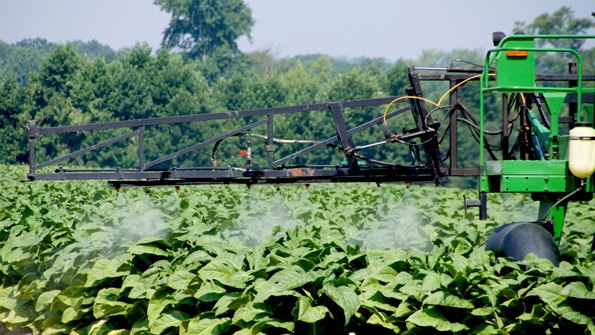Requirements updated for area surrounding pesticide application equipment that exists only during outdoor applications.

At Overman Farms in Goldsboro, N.C., on Thursday, U.S. Environmental Protection Agency Administrator Andrew Wheeler announced that the agency finalized important improvements to requirements for the pesticide application exclusion zone (AEZ) — the area surrounding pesticide application equipment that exists only during outdoor production pesticide applications. EPA’s targeted changes improve the enforceability and workability of the AEZ requirements, decrease regulatory burdens for farmers and maintain critical worker protections.
The revisions are consistent with the 2018 Pesticide Registration Improvement Act (PRIA). The AEZ requirements are part of EPA’s agricultural Worker Protection Standard (WPS) regulations.
"The changes to the AEZ requirements make it easier to ensure people near our nation’s farms are protected while simultaneously enhancing the workability of these provisions for farm owners and protecting the environment," Wheeler said.
This final action balances the input EPA received from a wide range of stakeholders during the 90-day comment period for the proposed action. EPA has clarified and simplified the AEZ requirements based, in part, on input from state pesticide regulatory agencies and agricultural stakeholders after adoption of the 2015 WPS rule.
Consistent with PRIA, EPA is only implementing changes related to the AEZ requirements in the WPS. These targeted changes include:
AEZ requirements apply only within the boundaries of the agricultural establishment, removing off-farm responsibilities that were difficult for state regulators to enforce.
Immediate family members of farm owners are now exempted from all aspects of the AEZ requirements. Farm owners and their immediate family are now able to shelter in place inside closed buildings, giving farm owners and immediate family members flexibility to decide whether to stay on site during pesticide applications rather than compelling them to leave, even when they feel safe remaining.
New clarifying language has been added so pesticide applications that are suspended due to individuals entering an AEZ may be resumed after those individuals have left the AEZ.
Simplified criteria to determine whether pesticide applications are subject to the 25 ft. or 100 ft. AEZ.
No changes were made to the “Do Not Contact” provision that prohibits a handler/applicator and the handler’s employer from applying a pesticide in such a way that it contacts workers or other persons directly or through drift.
“This action will make it easier for farmers and growers to comply with the application exclusion zone provisions by making them more effective and easier to implement,” EPA Region 4 administrator Mary S. Walker said.
U.S. Rep. David Rouzer (R., N.C.) was on hand for the finalization of improvements to requirements for the pesticide AEZ.
“Once again, this Administration is proving their commitment to adhering to the mission of a clean and safe environment while making commonsense reforms to rules and regulations that are unnecessarily onerous,” Rouzer said. “Administrator Wheeler and his team are a real breath of fresh air for North Carolina’s farm families who go above and beyond to protect the very soil and water necessary to produce the food and fiber that helps feed and clothe America and the world.”
North Carolina Farm Bureau president Shawn Harding said, “Farmers must have clear, effective and enforceable pesticide rules to work responsibly and efficiently, and North Carolina Farm Bureau commends the Administration and EPA for updating the pesticide application exclusion zone requirements to reflect that. We appreciate EPA’s continued vigilance over the safe use of pesticides critical to agriculture while giving farmers the flexibility and trust to grow food, fiber and fuel without excessive burden. Once again, the Administration and EPA Administrator Andrew Wheeler have demonstrated their commitment to sensible, science-based regulatory reform that provides practical and workable guidance to farmers feeding our nation and the world.”
National Association of State Departments of Agriculture (NASDA) chief executive officer Dr. Barb Glenn said NASDA members have emphasized the importance of including clear directives, flexibility for farm operators and high safety standards for farm workers in a final AEZ rule since the proposed language was published in 2019. “We’re pleased to see EPA adopted these priorities when crafting the final rule. In a time when certainty is valued more than ever, we’re thankful for the clarity the rule creates for farmers,” Glenn added.
NASDA said it will “continue to work closely with EPA as co-regulators on pesticide application to meet the responsibility of protecting the safety our nation’s agricultural workforce and economic viability of our farms.”
About the Author(s)
You May Also Like



.png?width=300&auto=webp&quality=80&disable=upscale)

